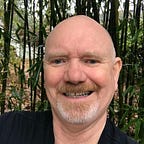Have There Always Been People on the Autism Spectrum?
What we now call autism has long existed among humans. But medicine only began noticing the particular set of physical and mental traits associated with autism within the last 100 years.
This issue has special relevance to me. I have an adult child diagnosed with Autism Spectrum Disorder (the diagnosis has shifted over the years from Pervasive Developmental Disorder, to Asperger Syndrome, to others I have forgotten). Trying to get help in the mid-1980s was a struggle-very few doctors and no schools I dealt with had any experience with a child that we now say is “on the spectrum.” Gradually I learned more, and found that the condition was not as unique as it first seemed.
This got me wondering-how would a person on the autism spectrum have fared before there was any awareness of the condition? I channeled my interest into a novel set in 1909, Into the Suffering City: A Novel of Baltimore, with a protagonist I imagined as autistic. My character, Sarah Kennecott, could not have been diagnosed as such in 1909 because the concept had not yet been invented. But I am confident that people such as her existed at the time.
The American Psychiatric Association’s Diagnostic and Statistical Manual of Mental Disorders identified Autism Spectrum Disorder in 2013. This is the latest of many (often, in hindsight, ludicrously inept) attempts by the medical profession to categorize a particular set of physical and mental traits. Children and adults with autism have difficulty with verbal and non-verbal communication. What follows is a non-exhaustive list of such traits as listed in the DSM:
Challenges in understanding or appropriately using:
- Eye contact
- Facial expressions
- Tone of voice
- Expressions not meant to be taken literally
Additional social challenges can include difficulty with:
- Recognizing emotions in others
- Expressing one’s own emotions
- Seeking emotional comfort
- Understanding social cues
- Feeling overwhelmed in social situations
- Gauging personal space (appropriate distance between people)
- Repetitive body movements (e.g. rocking, flapping, spinning, running back and forth)
Many clinicians and advocates hail use of the term “spectrum” because an autistic person is like any other-they are a unique individual with their own way of being in the world. As Dr. Stephen Shore has noted, “If you’ve met one person with autism, you’ve met one person with autism.” Those with autism range from people who are fully disabled to those who are highly functional and have great success in life.
I represent Sarah as gifted academically. While many, perhaps most, people diagnosed with ASD have lower than average intelligence (as measured by tests), there is evidence that some with autism have exceptional intellects, including “increased sensory and visual-spatial abilities, enhanced synaptic functions, increased attentional focus, high socioeconomic status, more deliberative decision-making, [and] professional and occupational interests in engineering and physical sciences.”
Broad public awareness of autism dates to the 1988 film , which starred Dustin Hoffman as an intensely awkward savant who could perform amazing, but highly selective, mental tasks. The film was useful for educating the public about autism, but also led to a general assumption that every autistic person was just like the Hoffman character. What we now call autism was largely unknown among the public prior to 1988. I know that from personal experience.
The first mention of autism in the DSM appeared in the 1980 edition. During the 1960s and 1970s autism was cruelly blamed on “refrigerator mothers” who failed to love their kids enough. Autism was also linked to schizophrenia as late as the 1970s. Leo Kanner in 1943 described a group of largely intelligent children who craved aloneness and “persistent sameness;” he called this “infantile autism.”
During the late 1930s and 1940s Hans Asperger used autism in reference to people with a perceived milder form of the condition that came to be known as Asperger’s syndrome. Eugen Bleuler coined the term autism sometime between 1908 and 1911 (there is disagreement as to exactly when) as a symptom of schizophrenia, another term that Bleuler invented. Bleuler derived autism from the Greek word meaning self, and used it in reference to people who lived in a world that was not accessible to others
But autistic-like behavior was noted long before the term itself came into use. As Kanner noted, “I never discovered autism-it was there before.” Samuel Gridley Howe gets credit for first noticing, prior to the American Civil War, that some people considered “idiots” had a combination of skills and strengths that set them apart from others with intellectual disabilities.
Looking back into history, it is arguable that many notable people, including Michelangelo, Emily Dickinson, Leonardo da Vinci, Isaac Newton, and Thomas Jefferson, were autistic. They and other, less famous, people with autism were different than ordinary people. This difference often led to cruel treatment; my character Sarah is variously called odd, strange, peculiar, and even “a spastic little freak.”
The modern neurodiversity movement urges replacement of the term “disorder” with “diversity” to account for neurological strengths and weaknesses and to suggest that variations in brain wiring-such as autism-can be a net positive for individuals and for society as a whole. Neurodiversity and autism advocacy groups share an even more important goal: insisting that people whose minds work differently are treated with respect and compassion.
Originally published at https://billlefurgy.com on April 8, 2020.
